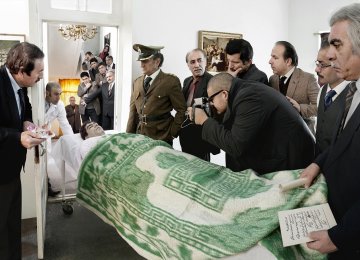Iranian professional photographer Azadeh Akhlaqi, has embarked on a new historical conceptual art photo project with some revision to her previous exhibit.
At a recent press conference, attended by Mahmoud Kelari, photography manager, Omid Rouhani and Iraj Raminfar, clothes designers, Ehsan Rasoulov, film producer and several other artists, Akhlaqi introduced her new ideas, Honaronline reported.
Her earlier project ‘By An Eye Witness,’ was one of the highlights of an exhibition of contemporary Iranian photography at London’s Somerset House last year. A conceptual art project, it took four years of research. It is a series that meticulously reconstructs 17 deaths from Iranian history “from the revolutionary sociologist who died mysteriously after being released from solitary confinement to the student activist shot by the secret police and to the mysterious end of Iran’s beloved gold-medal wrestler, Gholamreza Takhti,” said Rouhani.
The new concept is slightly different, more inclined to cinematic works, “although it is tougher than a movie project.”
It covers the time span from 1865 until the 1979 Islamic Revolution, and includes the Persian Constitutional Revolution, (1905-1907). Thus, “it is a rich historical project with landmarks of Iran’s history,” Rouhani added.
Scenes are simulated in a narrative style and then captured on lens. A professional crew is set to work on the art project, he noted.
The new series is a narration of historical events in a specific period of time and is different from the earlier collection in that it is not mere simulation, said Akhlaqi. “I’ve chosen three important events in Iran’s history, the 1921 and 1953 coup d’états and the end of the Constitutional Revolution in 1907,” she added.
Skilled Artists
Skilled theatre artists are chosen to pose in the designed frames, which are set according to the evidence of old photos and storyboards.
The whole idea began six years ago when “I began to think about the revival of our history and all the freedom fighters who died in heartbreaking circumstances.”
“I started doing research and tried to focus on the people who died in a tragic way, but as there were no cameras around to capture the moments, their death has gone somewhat unnoticed. Most of the deaths represented are not only tragic but also crucial turning points in the particular kind of struggle they represent. In other words, you could always say that if they hadn’t died in that particular moment, our history would have been different.”
Kelari said being involved in such an art project is challenging. “It is interesting to work on an art project that is a combination of photography and cinema. We will have an installation and I will be there as a cinematographer.”
Akhlaqi, 37 was born in Shiraz and studied computer science. She took up her career as a conceptual artist in 2001.
Her main subjects are photography, video arts and short movies. She has made several short films, which have been screened in numerous film festivals such as the Berkeley Art Museum, Pusan and Oslo.
From 2001 to 2010, she participated in numerous art exhibitions in Iran, Australia, England and Turkey. Akhlaqi has also won a number of international prizes including the third prize of the UN Habitat Photography Competition and the first prize of the Women and Urban Life Competition of Iran.





